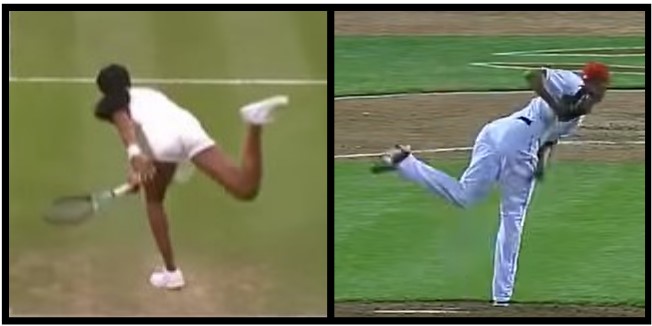You’re 5’ 9’’, 140 lbs (1.79m, 64kg), and female. How hard can you serve?
Answer: at least 124 mph (200 km/h), because that’s how fast the rocket Coco Gauff threw down in her third round match at Wimbledon 2022 exploded off her racket.
Coco is one of the most explosive athletes on the planet, but even still, a serve with that level of blistering speed is impossible without exceptional technique. Let’s dive in.
Preparation
Coco uses the textbook preparation position I want you all to adopt. She locks her hitting arm in at 90-90, maintains a straight, stable core, tilts backwards, and then explodes upwards and forwards.
The 90-90 position allows the arm to safely absorb the velocity generated by stronger muscles of the legs and trunk:

If the elbow is too high, the shoulder becomes impinged as it tries to internally rotate. This will always decrease velocity, and often strain the shoulder.
If the elbow is too low, the serve will typically end up fine, but won’t have quite the velocity as if it were higher, and thereby farther from the trunk.
If the elbow is too bent, similar to the low elbow, the serve will typically be fine, but lacking the velocity generated by the longer lever of a 90 degree elbow.
If the elbow isn’t bent enough, there’s more force applied to the inner elbow during arm acceleration. If you’re serving pain free, that’s fine, but this is the force that sends pitchers to the operating table for Tommy John surgery.
Swing Initiation

Coco drives off the ground and explosively twists her torso around. As she twists, her arm is driven forward and upward. This rotation is about the axis of her spine, and because she is tilted upward, her arm is flung upward by this rotation.
Many rec players mess up here, and pinch their shoulder in towards their cheek in order to “swing up.” Coco, on the other hand, has her arm almost completely out to her side. The upward nature of the swing is created by the orientation of her torso, not by moving the arm up by itself.
Her arm doesn’t come forward by itself, but rather as a result of the strong muscles of her trunk twisting her. The twisting action starts from the ground – her knees extend to initiate her motion – and continues into her trunk, as her erect, stable core spins around.
The Hand Vector

After the arm is flung by the trunk, it rotates internally at the shoulder (If you see “ISR” that’s a reference to this: “internal shoulder rotation”). This rotation, during a tennis serve, is what causes the strings to slap the ball flat into the service box.
Here, Coco is aiming down the T. Her hand is thrown towards, roughly, the center of the ad side service box. As the shoulder internally rotates, the racket slaps the ball off to the left of Coco’s hand trajectory.
The hand itself is not thrown towards the serve’s target.
The partial orthogonality between hand trajectory and ball trajectory is critical for high velocity serving. In order for Coco to harness her throwing mechanics, she must launch her hand to the right of her serve target, because when her shoulder internally rotates, it’ll cause the racket to slap the ball left of her hand’s trajectory.
Follow-Through
A stroke’s follow-through provides useful information about how it was executed, even though the ball is already gone. In Coco’s follow-through, we see her right leg kick up and back – her foot almost hits her butt.
Why?
Because that’s what happens when a server rotates about their spine explosively. Look at any MLB pitcher, and you’ll see a very similar back leg kick up.

Do not try to kick your back leg up. That won’t help. Instead, if your back leg is not kicking up, focus on rotating with more force into your shot. If you rotate faster, your body will naturally decelerate that velocity by kicking the back leg up.
If your back leg is kicking around to the side (more like a pitcher’s) instead of up, you need to transpose your rotation. You are treating the serve as a forward throwing motion, and need to throw up more. Imagine serving by throwing your racket at the ceiling on your side of the court, and then adjust from there.
If your back leg still isn’t kicking like Coco’s, the issue probably isn’t your force production, but rather your force translation – your suboptimal posture is preventing the force from exiting your core and accelerating your arm. Focus on your butt, ab, and back stability.
If I freeze frame you at the moment you initiate your swing, I shouldn’t be able to bend you. I’m going to try to bend your trunk at every angle: push back, forwards, left, right. You shouldn’t bend. The better your posture, the more efficiently force is transferred. The force you generated off the ground will end up accelerating your arm more the less of it is lost bending your core around as you explode.




